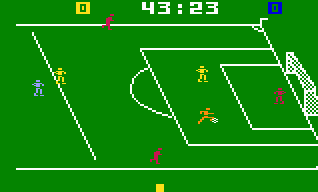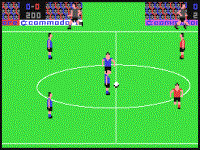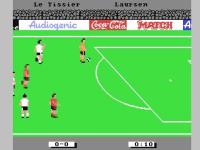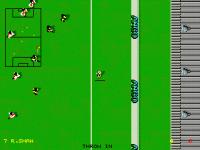



Those
of us aged more than twenty-five may remember the old Binatone/ Grandstand
consoles with their tennis/ squash/ soccer games (Pong) in the mid/late 1970's. The games
consisted of two or four moving sticks on a lifeless screen. Then come
Intellivision with its superb soccer simulation and this proved to be the major
turning point for soccer games. I can still remember the excitement of seeing my
'matchstick' men run up-and-down the pitch in glorious 3D. This game, however,
was a two player game only - but there is no denying it's good looks and feel
(In 1986 Intellivision released a follow-up called World Cup Soccer; this had
the option of a one/ two player game and also had fouls and free kicks.) Soon,
Atari and Acetronic consoles had their say in the soccer games market but these
attempts made no notable leaps.
 Now,
this is where Andrew Spencer comes into the picture! In fact, for five years he
ruled computer soccer games with his International Soccer, released in 1983 with
the then new Commodore 64. It introduced the 'bouncing ball' to computer soccer
games and also boasted nine computer skill levels. This game was quite simply a
'revelation' and within two years it conquered Europe. So, what became of
Andrew Spencer? He followed-up his soccer achievements with a basketball game
called, yes you've guessed it, International Basketball, and shortly afterwards
emigrated to America.
Now,
this is where Andrew Spencer comes into the picture! In fact, for five years he
ruled computer soccer games with his International Soccer, released in 1983 with
the then new Commodore 64. It introduced the 'bouncing ball' to computer soccer
games and also boasted nine computer skill levels. This game was quite simply a
'revelation' and within two years it conquered Europe. So, what became of
Andrew Spencer? He followed-up his soccer achievements with a basketball game
called, yes you've guessed it, International Basketball, and shortly afterwards
emigrated to America.
The
Spectrum, which was in competition with the Commodore 64, needed a game to
compete with International Soccer, so when Artic Software announced the imminent
release of World Cup Soccer, expectations were high. However, the game proved to
be very poor. When in possession of the ball, all you had to do was run in a
zigzag fashion towards goal and shoot past the advancing computer-controlled
keeper. Easy! Jon Ritman from Ocean Software produced Match Day in 1985 and this
proved the game all Spectrum owning soccer addicts wanted. It shot to the top of
the charts and stayed there for two months. This game introduced the shot
power-bar to computer soccer. Jon Ritman followed his success with Match Day 2
which appeared not only for the Spectrum but also the Commodore 64 and Amstrad
464 machines. He then decided to leave the home-computer games market to
concentrate on producing arcade games. He returned to the PC market with
Supermatch Soccer.
 About
this time, the best-selling game of all time (helped by the fact that it was
released on most computer formats) was Football Manager by Kevin Toms of
Addictive Software but we do not wish to stray onto management sims so enough
said! Soon Anirog released 5-A Side Football. This game added a crowd chanting
" 'ere we go', 'ere we go', 'ere we go', " and players fought when a
foul was committed (Anirog later changed their name to Anco and would later have
a big say in the development of computer soccer).
About
this time, the best-selling game of all time (helped by the fact that it was
released on most computer formats) was Football Manager by Kevin Toms of
Addictive Software but we do not wish to stray onto management sims so enough
said! Soon Anirog released 5-A Side Football. This game added a crowd chanting
" 'ere we go', 'ere we go', 'ere we go', " and players fought when a
foul was committed (Anirog later changed their name to Anco and would later have
a big say in the development of computer soccer).
I
feel morally obliged to mention an occurrence in 1986, so here we go ('ere we
go', 'ere we go', 'ere we go'). US Gold obtained the rights to publish the
official 1986 World Cup game. They actually advertised this game nine months in
advance and when it finally arrived, it shocked the gaming world. They acquired the rights from Artic Software for their World Cup 2 game which was around
two years old and then added a 'skills section' to the game whereby the player
tried to keep the ball in the air for as long as possible. This was sold along
with some stickers and a badge for fifteen pounds (a lot of money in those
days). I can recall that when playing against the computer-controlled teams,
they were never sure which end to attack (the right or left goal). I can laugh
now but believe me, it was no laughing matter at the time.
 In
1988 Audiogentic released Emlyn Hughes International Soccer for the Commodore
64. This game set new standards! It was, basically, an updated version of
Spencer's International Soccer with added frames of movement to the player's
sprites thus giving a more fluid look. The options and menus within this game
was mind-blowing! The sliding tackles and long/ short passing and shooting added
to the skill aspect so you could play like the one-touch Brazilians or the
long-ball Dons (Wimbledon).
In
1988 Audiogentic released Emlyn Hughes International Soccer for the Commodore
64. This game set new standards! It was, basically, an updated version of
Spencer's International Soccer with added frames of movement to the player's
sprites thus giving a more fluid look. The options and menus within this game
was mind-blowing! The sliding tackles and long/ short passing and shooting added
to the skill aspect so you could play like the one-touch Brazilians or the
long-ball Dons (Wimbledon).
 By
1989, the 8-bit machines were replaced by their 16-bit counterparts notably the
Amiga and Atari ST. Steve Screech and Dino Dini from Anco software (formally
Anirog Software) produced Kick Off. "The original Kick Off took us about
eight months to produce which is not very long at all", explains Steve
Screech, "Dino and I were inspired by Ocean's Match Day 2 but we wanted the
players and pitch to be correctly scaled ... allowing players to show real
skill." Kick Off was different in more than one way to any other offering
at the time. First of all it gave the player a top-down view of the pitch rather
than the popular side-on view; also the ball did not 'stick like glue' to your
sprite when in possession thus you had to control the ball which was not easy to
begin with. Both these aspects added a new dimension to computer soccer. Kick
Off 2 was released in time for the 1990 World Cup. It was a big improvement over
its forefather but a little of the smoothness was lost. Nonetheless, it was a
world beater and was the benchmark for all new soccer games, until the
release of Sensible Soccer.
By
1989, the 8-bit machines were replaced by their 16-bit counterparts notably the
Amiga and Atari ST. Steve Screech and Dino Dini from Anco software (formally
Anirog Software) produced Kick Off. "The original Kick Off took us about
eight months to produce which is not very long at all", explains Steve
Screech, "Dino and I were inspired by Ocean's Match Day 2 but we wanted the
players and pitch to be correctly scaled ... allowing players to show real
skill." Kick Off was different in more than one way to any other offering
at the time. First of all it gave the player a top-down view of the pitch rather
than the popular side-on view; also the ball did not 'stick like glue' to your
sprite when in possession thus you had to control the ball which was not easy to
begin with. Both these aspects added a new dimension to computer soccer. Kick
Off 2 was released in time for the 1990 World Cup. It was a big improvement over
its forefather but a little of the smoothness was lost. Nonetheless, it was a
world beater and was the benchmark for all new soccer games, until the
release of Sensible Soccer.
 In
many ways Sensible Soccer copied Kick Off (same top-down view and 'glueless
ball') although the top-down view was slightly more angled than in Kick Off. SWOS
(Sensible World of Soccer) was released in 1993. This was the Sensible
Soccer game engine with the added element of managing. The aim is to get job
offers which the later incarnation of SWOS allowed up to international level i.e
managing international teams and taking them to the World Cup etc. Prior to
this, in 1992, Electronic Arts released FIFA Soccer for the Megadrive. It was a costly
license but has since proved a good one. The original FIFA seemed to try to win
fans over through the brilliant graphics. Konami released International
Superstar Soccer for the SNES in 1994 which also had a massive following.
Similar to FIFA Soccer, it too has had regular upgrades. The original I.S.S. can
be traced back to a game called 'Soccer' released on the M.S.X in 1984.
In
many ways Sensible Soccer copied Kick Off (same top-down view and 'glueless
ball') although the top-down view was slightly more angled than in Kick Off. SWOS
(Sensible World of Soccer) was released in 1993. This was the Sensible
Soccer game engine with the added element of managing. The aim is to get job
offers which the later incarnation of SWOS allowed up to international level i.e
managing international teams and taking them to the World Cup etc. Prior to
this, in 1992, Electronic Arts released FIFA Soccer for the Megadrive. It was a costly
license but has since proved a good one. The original FIFA seemed to try to win
fans over through the brilliant graphics. Konami released International
Superstar Soccer for the SNES in 1994 which also had a massive following.
Similar to FIFA Soccer, it too has had regular upgrades. The original I.S.S. can
be traced back to a game called 'Soccer' released on the M.S.X in 1984.
And this is really the end of the early history of computer soccer.
I wish to add this paragraph to the end of my article to give - an ever so slightly - current feel to this page. Konami's Pro Evolution Soccer is generally credited as the most convincing video game representation of the world's favourite sport. This game first released in Japan as Winning Eleven 5 in 2001 has since been updated - and named (shock, horror) winning Eleven 6 and Pro Evolution Soccer 2. Not to be confused with ISS, PES differ to both Electronic Arts' FIFA and Konami's other soccer game ISS games in that it is a simulation (and takes time to master) whereas FIFA/ ISS are more pick-up-and-go arcade games.
By Crispin Salfarlie.
| 1975 | Pong |
| 1979 | Soccer (Intellivision) |
| 1983 | International Soccer (C64) |
| 1988 | Emlyn Hughes Int. Soccer (C64) |
| 1989 | Kick Off (Amiga) |
| 1993 | SWOS (Amiga) |
| 2001 | Pro Evolution Soccer (PS2) |